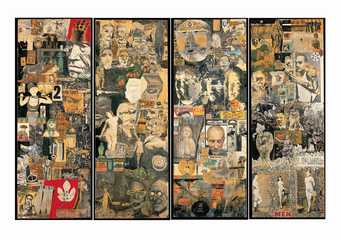Discover the collages of Nigel Henderson, which assemble fragments of image and text to activate them in new ways
In his collage work, Henderson assembles fragments of image and text in order to activate them in new ways. He wrote: ‘I want to release an energy of image from trivial data. I feel happiest among discarded things … fragments cast casually from life, with the fizz of vitality still about them.’
Henderson created the collages in this room between the late 1940s and the end of the 1970s. They bring visual scraps of modern British life into dialogue with imagery from other places and periods. His intricately layered collages reflect on the passing of time. They dwell on natural decay, the ruins of war, and the crumbling of empires. They also engage with the visual culture of their own time and cast a critical eye across contemporary images intended to stimulate aspiration, consumption and desire.
Henderson was aware of the historical legacies of collage. His work refences the Victorian hobby of ‘découpage’, decorating objects with paper cut-outs. The subversive collages of dada and surrealist artists in the early 20th century provided him with other important precedents. At the same time, his work engages with more recent artistic developments, including the rough textures of brutalism and the bold graphics of pop art.
Henderson’s creative practice spanned fine art, photography, exhibitionmaking and interior design. Collage was always at centre of his thinking. As one critic observed, ‘Whether the medium is man, nature, time, weather, or even words, the underlying idea of this artist’s vision is that of collage.’
Curated by Mark Hallett, Paul Mellon Centre for Studies in British Art and Rosie Ram, Royal College of Art, with Zuzana Flaskova, Tate Britain.
This display has been produced in collaboration with the Paul Mellon Centre for Studies in British Art.
Tate Britain

